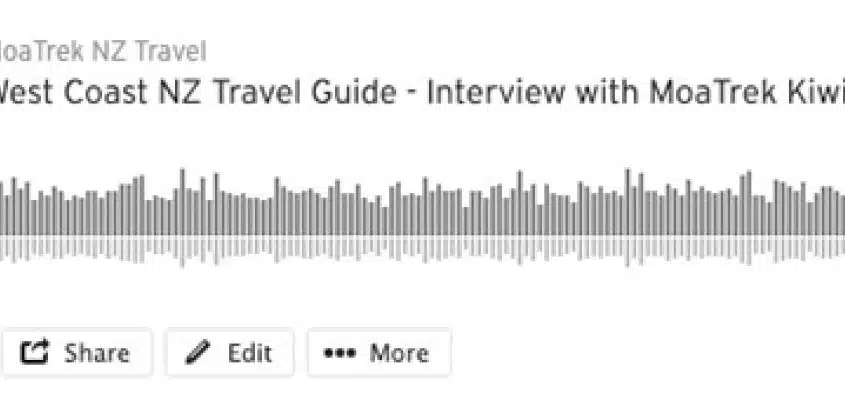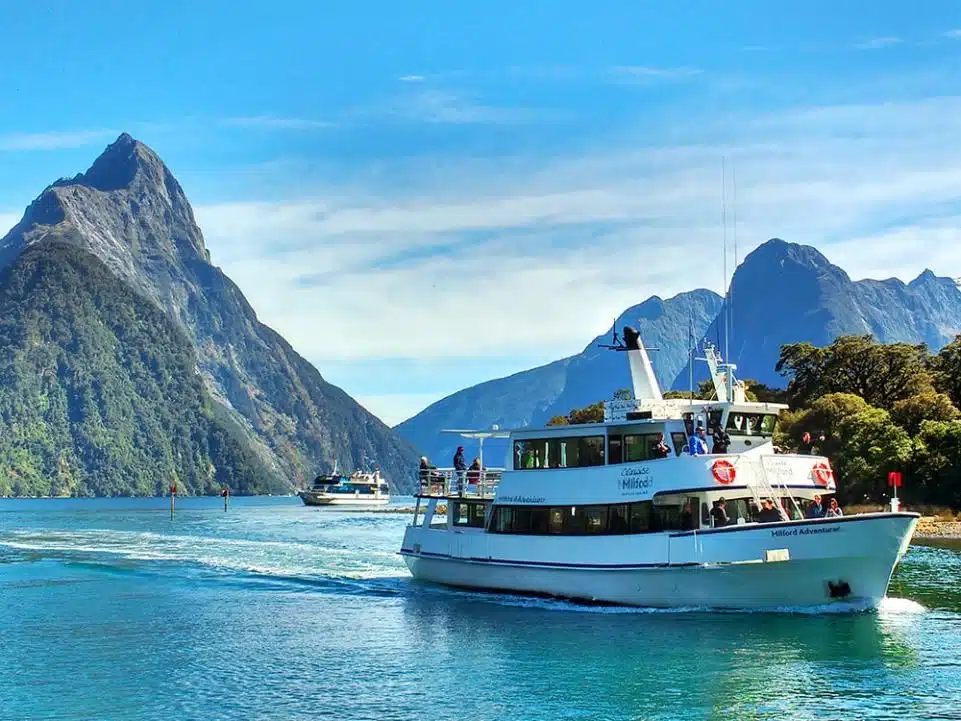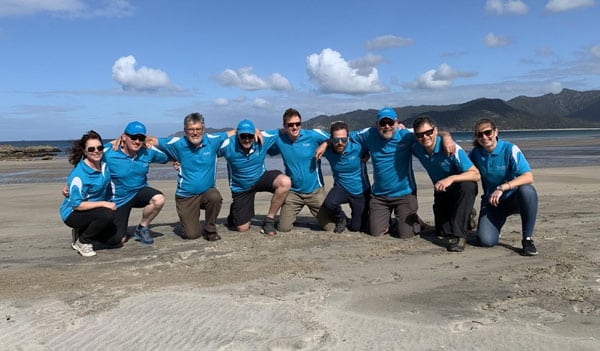MoaTrek Kiwi Guide Marilyn (known as “M” to her many friends and guests) has been guiding on the West Coast of the South Island since 2005, in this audio interview she chats with Andrew about her favourite places, people and experiences on the Coast. Marilyn guides travellers through the West Coast on the MoaTrek Kea 7 Day Small Group West Coast tour.
The full interview is just under an hour and you can listen by clicking here on the SoundCloud file below. There’s also a full transcript of the interview on this page below and we’ve inserted the pictures into the page at the appropriate spot so you can see what they’re talking about.
Full transcript of the interview with MoaTrek Kiwi Guide Marilyn
We’re talking today to one of our favorite people, our favorite Kiwi guides, Marilyn. Marilyn is known as “M” to many of our guests. And we’re chatting with her about a part of the country that she loves and we all love very much, the West Coast of the South Island, so from Queenstown, over to Wanaka, all the way up through the glaciers, and to Punakaiki, and back over Arthur’s Pass, that’s the route that we travel up the West Coast. And we’ll be hearing from Marilyn, all the places she loves on this route, the people she meets, some of her stories from guests she’s shown around over the years, and her own experiences on the West Coast. So we hope you enjoy this chat with Marilyn.
Marilyn: Yeah. And, later on, I traveled, and then teaching and the guiding happened because I decided to take a semester off teaching, and a friend said, “What are you going to do?” And I said, “Oh, I think I’ll have a go as guiding job. It can’t be that much different from teaching.” And I was really lucky. And at the time I wanted it, there was a company needing a female cycle guide, so everything fell in place.
Andrew: Oh, right. And when was that? When did you start guiding?
Marilyn: 2005, so almost 20 years ago. And my very first group was a group of women, and the company had promised the group coming to New Zealand would have a female guide, and that time they didn’t even have one on the books. So I loved the time with them, and after that experience was time guiding in India with a company.
Andrew: It was cycle touring in India, as well, was it?
Marilyn: Yes. Some wonderful parks of Rajasthan and southern India, so slightly different from guiding for MoaTrek in New Zealand.
Andrew: I’ll bet it is. So plenty of stories from that. And what about the West Coast of the South Island? Can you remember the first time you ever went there, not even on a guiding trip, but can you remember the first time you ever visited the West Coast?
Marilyn: Oh, yes. It was an enormous adventure for us. So, Dad believed in summer holidays, and so he loaded four children, camping gear, and us all into a short-wheel-base Land Rover, and we headed to the West Coast of the South Island. And it was an old canvas top. So when it got really hot, he rolled the sides up. A lot of the roads were still gravel, so it was quite dusty. And we had a wonderful time down the coast, collecting gemstones, swimming in the lakes. That was my fist introduction, and my first aeroplane flight. So we got to fly out onto the neves above Franz and Fox Glaciers.
Andrew: Oh, that must have been cool. And, thinking about guiding down the West Coast, can you tell us about some places that you love on the West Coast to visit when you’re guiding, any places that are special to you?
Marilyn: Oh, I’ve got a couple of favorite spots, and one of them is Ship Creek, which is just north of Haast. And it doesn’t really matter whether it’s raining or the sun’s shining, it’s always a great stop. It’s a beautiful walk in the forest, and if we get the season right, the native orchids and for those that love beach combing, there’s always some really pretty stones on the beach. And often if we are wee bit patient, we can see the Hector dolphins just off the coast. So, really lovely spot. And my other little one is Lake Mahinapua just before Hokitika. And the bus drives down a little narrow road, and the forest folds over the roof of bus, it gives you an insight of what the forest might’ve been like when the early settlers started, and the gold miners worked their way down the coast.
Scroll through some recent photos from Ship Creek
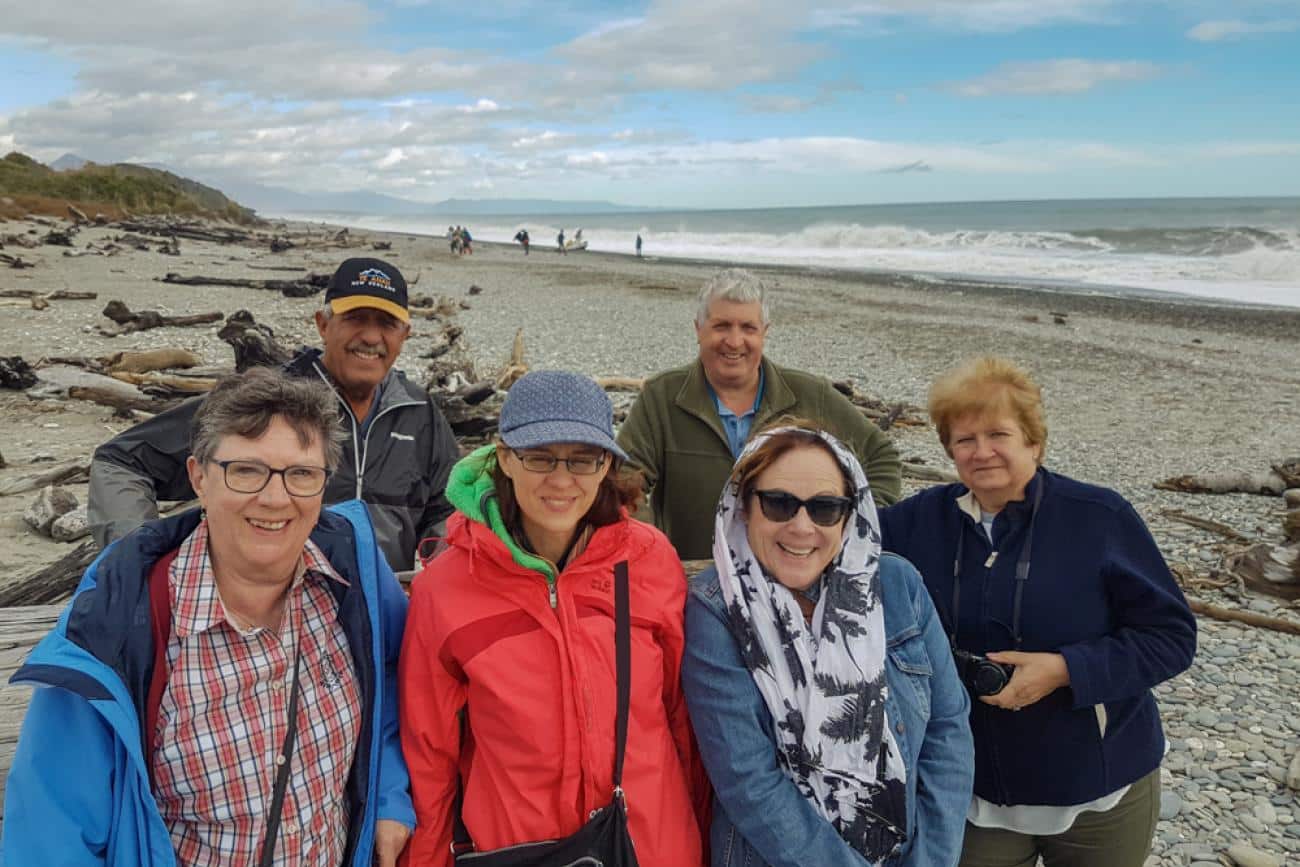
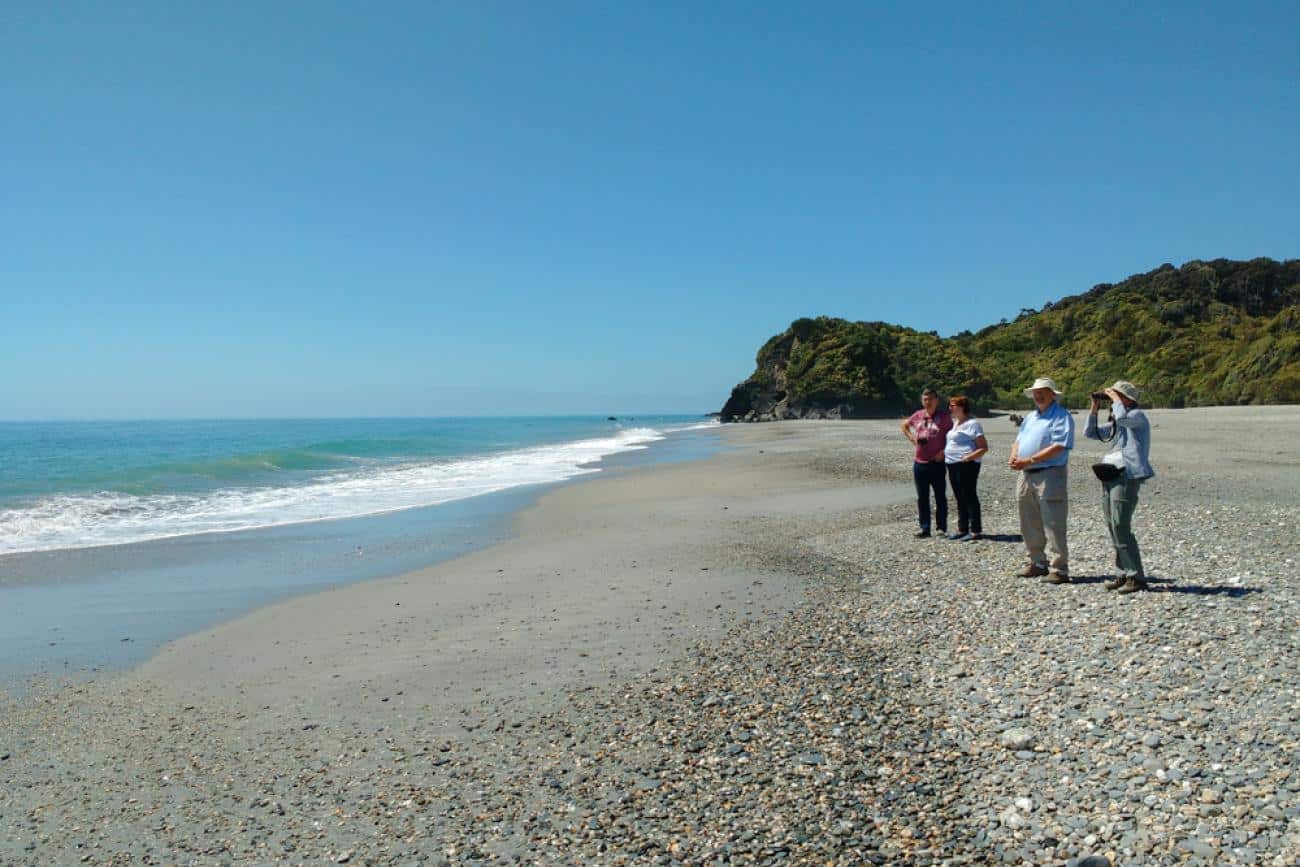
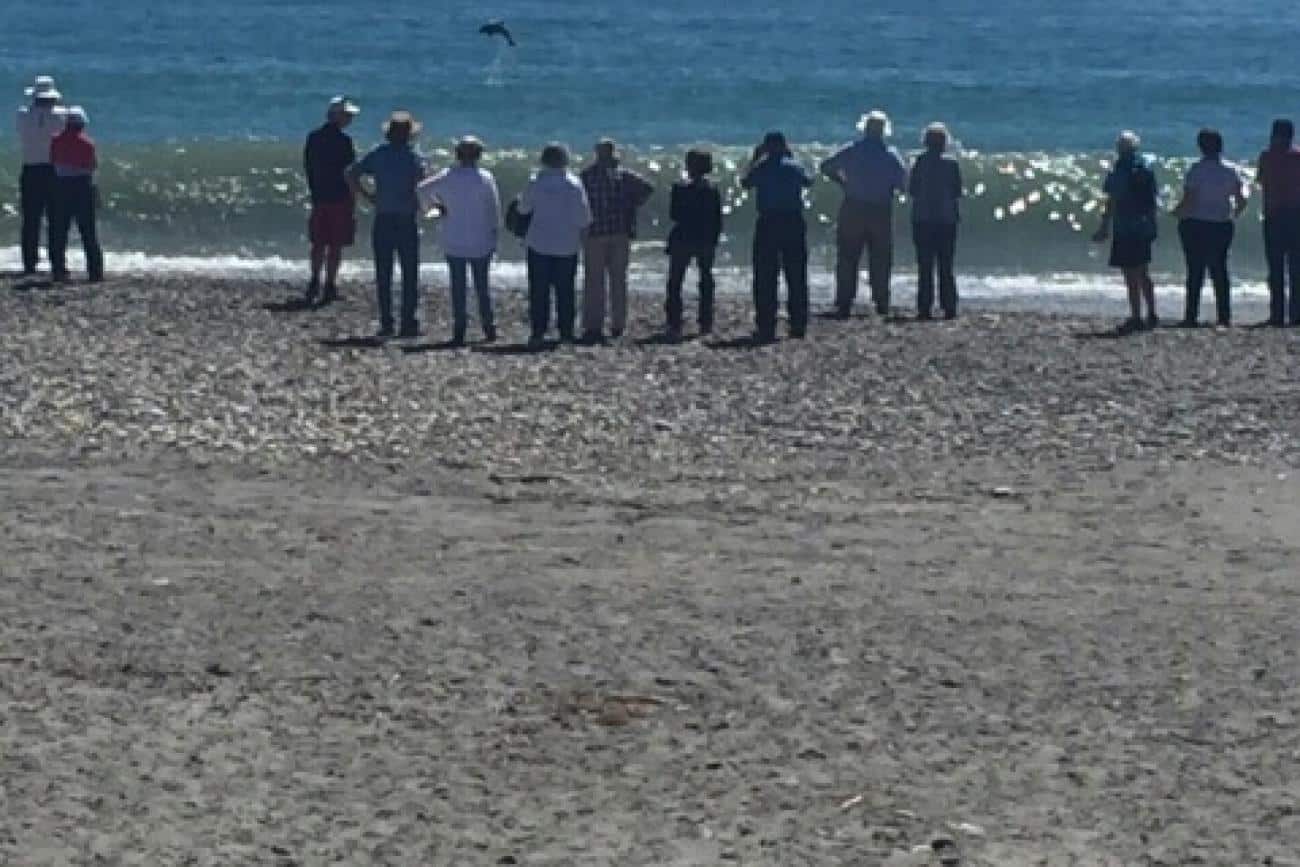
Andrew: Yeah. That’s that famous cheese ad on TV, isn’t it? The Mahinapua Hotel there?
Marilyn: That’s right. So that was then before, I think, they put the road in front of the hotel. But at Mahinapua, too, quite often you’ll see after breeding season, you’ll see the White heron on the lake. So it’s a really nice little spot.
Andrew: Yeah. So I love those spots. It was you that told me about Ship Creek actually, first time I ever went.
Marilyn: Ahh. No. It’s a great spot, and you can always pull out an umbrella, and the weather seems to usually be kind to us there.
Andrew: Yeah. I mean, the number of times I’ve seen dolphins from Ship Creek just standing on the beach is surprising, and so it’s amazing that you can just drive up to a beach and look out and see dolphins, not obviously every time, but quite a few times. It’s an incredible spot.
Marilyn: Yes. I think that wee pod lives off the coast there. I always say if you wait for 20 minutes, you’ll always see one, just not necessarily doing a wonderful display of jumping, but occasionally that happens, too.
Andrew: I have seen that there. Yeah. And they’ve built that observation look-tower, so they must be there enough if the national park thinks it’s worth enough to build a proper permanent observation tower, you can climb up and look for them.
Marilyn: Yes. Actually, my biggest luck has been off the beach. I think they’re quite close in.
Andrew: And, when you’re traveling on the coast, what is it that makes it different? What is it makes it special for you? And thinking about, well, when you’re guiding, you know, when people come from overseas, what do you think makes the coast such a great place for people to visit, you know, as opposed to other parts of New Zealand?
Marilyn: I’ve thought about this, and I think it’s the wilderness and the raw energy of the coast, on a day where the Tasman Sea crashes in on those beaches. You can see the real energy of the sea, but also the forest, it’s a temperate rainforest and it’s quite different from what many people expect or see.
And the other wonderful thing is you can take people for those short walks, and there’s no nasties. There’s no snakes or anything that’s going to…and the people struggle to…overseas people often struggle to comprehend that. But, yeah, I think it’s the raw energy, it’s the water, and actually the specialness of the folk. People on the coast are survivors, are tenacious, and they’re innovative. And so there’s a whole combination of that that… And I guess memory has a lot to do with it. You develop an affinity for a place, and you carry it with you.
Andrew: Yeah. So many of us have stories on the coast. I went on holiday on the coast as a kid, too. So it’s really cool to go back to those places with people that you’re showing around on their holidays as well.
Marilyn: Yes. And we did field trips there as university students, too.
Andrew: Bet you didn’t get any work done!
Marilyn: There was a little bit…yes, there was work done. Also how much the coast has changed. So I often think of Truman’s Beach at Punakaiki, which is a gorgeous walk, and when we were at university, we pushed our way down through this tiny little track and climbed down probably a less than safe ladder onto the beach. And these days it’s a very nice track down with good stairs down to the beach, so quite changed.
Andrew: Yeah. That’s an amazing hidden little beach, isn’t it? And it’s a little spot that’s actually quite easy to get to, and you feel like you’re walking out into some deserted island, don’t you, when you hit that beach?
Marilyn: Yes. And if the tide’s in, there’s not much beach.
See some recent pictures from the Truman Track
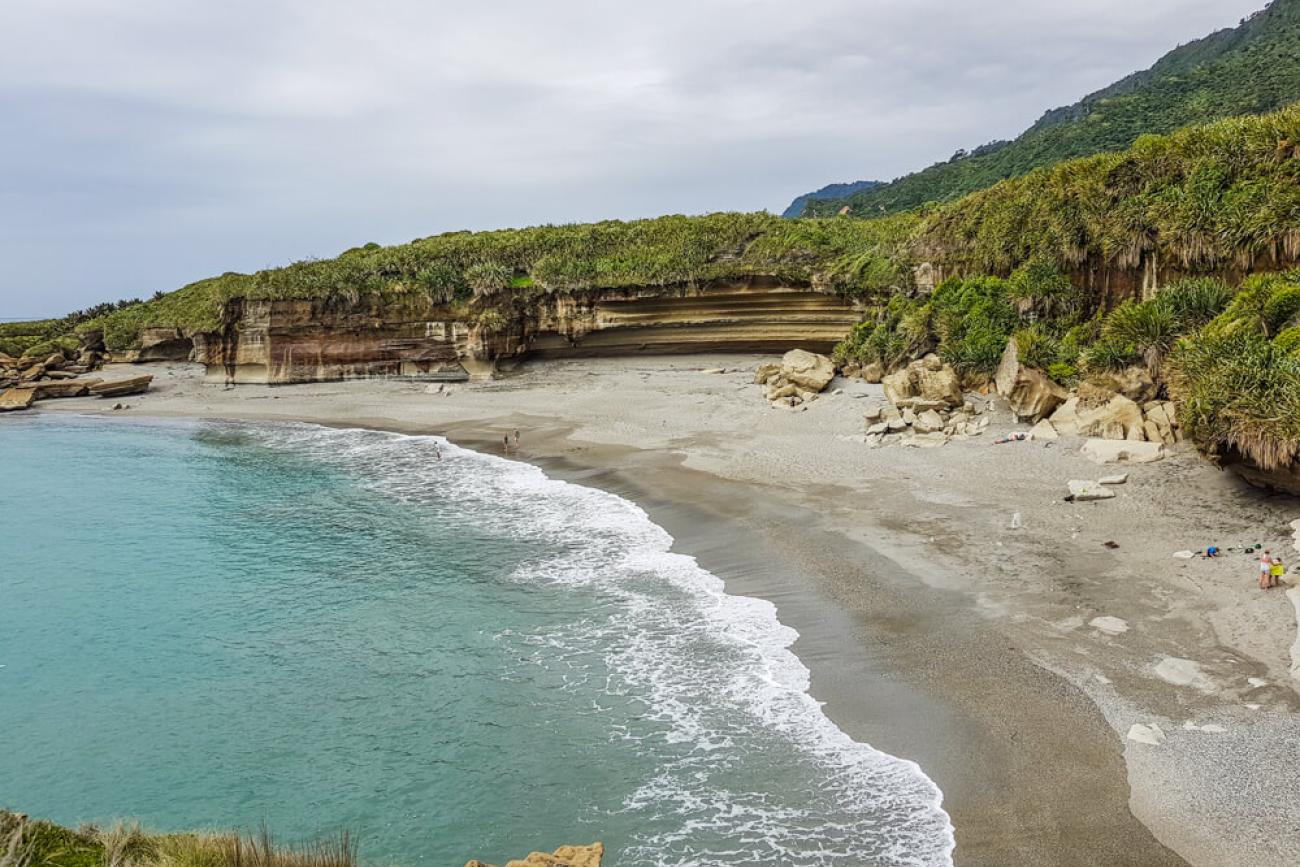
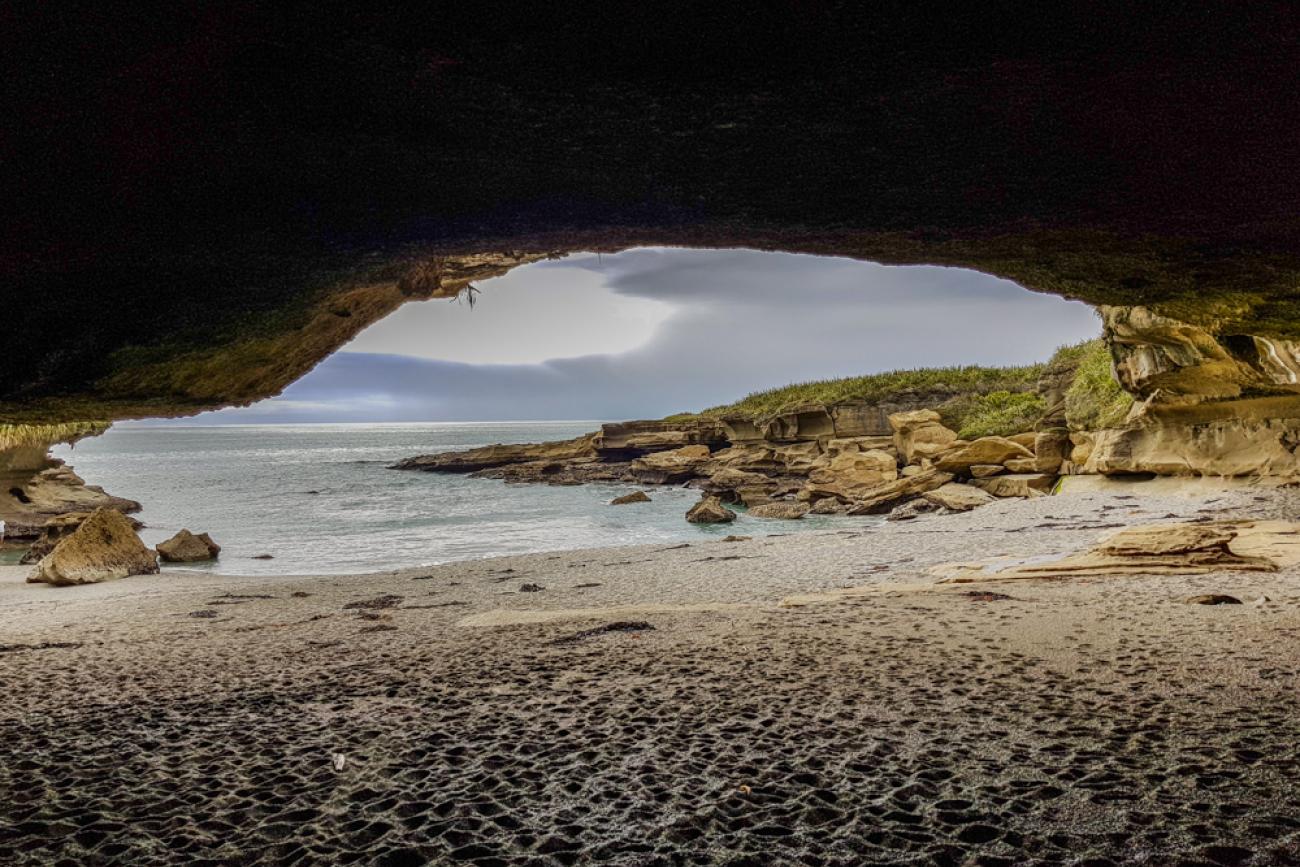
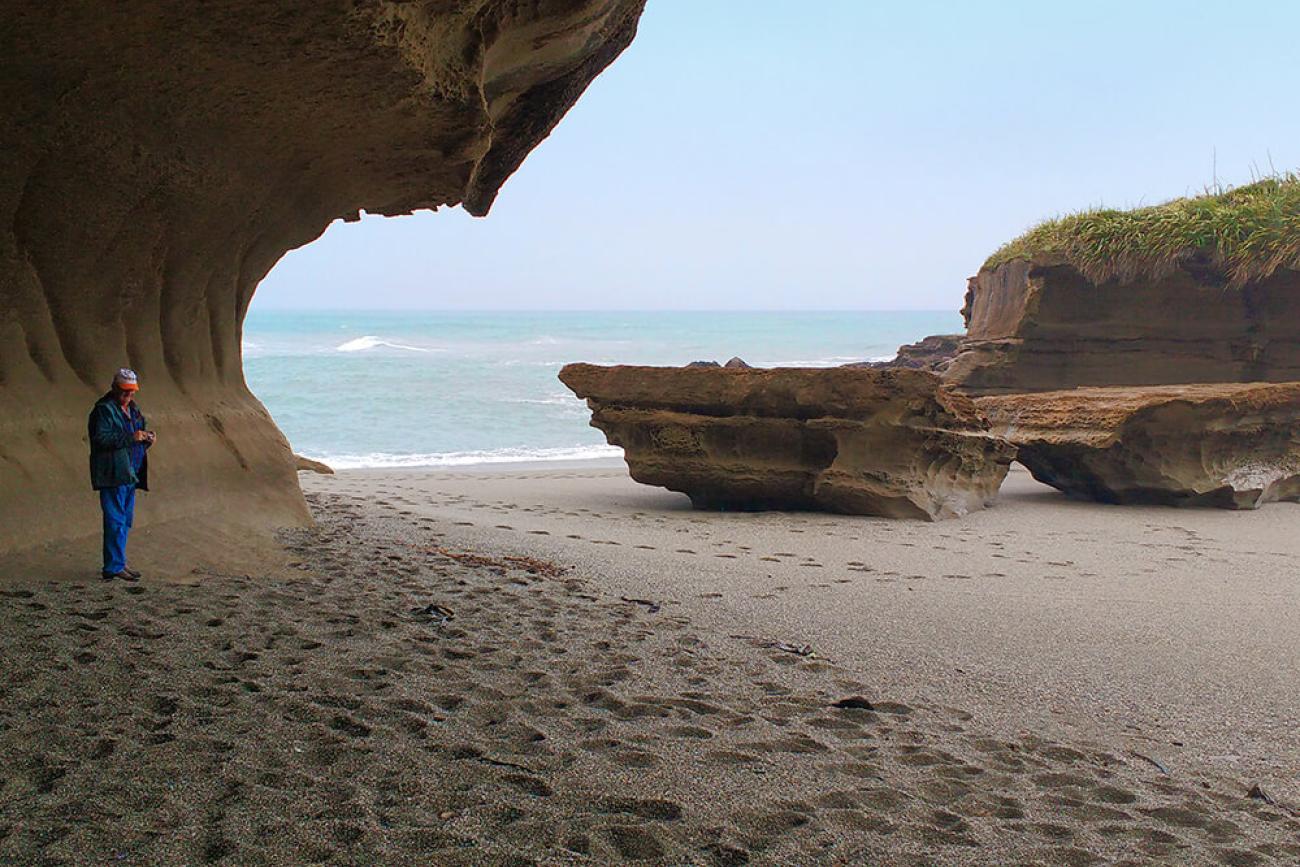
Andrew: Do you have any memory of…special memory from guiding on the coast, whether it’s a place or a person, someone that you were…I guess, from one of your tours that sticks in your mind as someone, a visitor to New Zealand really being kind of wowed, or having a moment that they’ll remember on the coast? Is there anything that you can think of like that?
Marilyn: Oh, there’s one. Well, it’s actually several, but one of the ones. In Hokitika there’s a woman we call sock lady. She has knitting machines and sells all over the world, and she also sells socks. And one of my passengers had bought a knitting machine online of her, and came rushing back to the bus to say, could she have a little bit more time because she discovered the woman who’d sold her the knitting machine? And she had all these questions. So she was really, really excited, and it was lovely to see. And another one was a couple of English people who I encouraged to do Johnny’s Tour. And they were a little apprehensive about it, but also didn’t have the cash.
So I paid for the trip and see if they really didn’t like it. We’d give them their money back. And they came back saying that it should be compulsory, and it was the best part of the trip. And Johnny is a wonderful old coaster who has been a logger, a gold miner, and that lives in this absolutely beautiful forested valley, and great storyteller. And this last season, I’m not sure if you’re aware that we stopped and asked for somebody…well, as general stop, but a man rushed up and asked if he could have a photograph with us. And I thought that was a really unusual request, but we said yes. And he’d traveled with the company 35 years ago and was still excited about the trip he’d done back then. So that’s pretty amazing.
Andrew: Yes. I do remember that. He was wearing a Hawaiian-type shirt in the photo, if I recall?
Marilyn: That’s right. And Ena still had photographs of that trip to share with him.
Andrew: Yeah. I think, yeah, I remember his shirt clashed slightly with the aquamarine on the MoaTrek bus if I recall. I remember being in Hokitika once, not long after “The Luminaries” novel had come out, as a guide, a lady on the trip came back after our stop there and told me that she’d walked around all the stops that they mentioned in the book. And I was so impressed. You know, she was so excited. She’d come back, and she had a map of the old town from the novel, and had walked around all these places, and it was like stepping into the pages of the novel for her. It was incredible.
Marilyn: Hokitika is just thought as…so many things to do in Hokitika really. That links to that book, but also just the general history and the walk along the riverbed, the carving and the beautiful old buildings. And I think they’re just been funded for that some of the earthquake restructuring there. It’s great.
Andrew: And then, what are some activities that you see people enjoy the most on the coast? And you mentioned Johnny’s, which is the Johnny’s Journey Tour. It’s actually out of Westport, but he’ll come down and, quite often our guests do it on their day off in Punakaiki on the tour, the MoaTrek tour. But is there anything else that you recommend…and not just talking about, like, activity, so much as a guided walk or something, but something even off the wall a little bit, or some kind of food, or personality that you think is a great thing for guests to do when they’re visiting the coast?
Marilyn: So, well, there’s plenty to do, but sometimes, depending on my bus group, we stop off Curly Tree just out of Haast, where they sell whitebait patties, and really good whitebait patties. And the folk there are great because they talk about the whole history of the whitebait and the coast and the process. So that’s a little stop that people often enjoy.
Andrew: So, for anyone who doesn’t know, what’s a whitebait, and why is it so important on the coast? Why are they so important on the coast?
Marilyn: Whitebait is the immature, or the fingerling of a little native trout, or several little native trout actually. And there’s a season for catching them, and the coast rivers are great breeding rivers for them. So, during August to November, yeah, whitebait fever, everybody is out catching whitebait. And they’ve got a very subtle flavor, and people either like them or don’t, it depends if you like to see the little eye looking at you from the patty.
So that’s one of the things, but on the days off at Punakaiki, people quite often just enjoy walking up the Pororari gorge, with wonderful limestone bluffs above. And people can walk up as far as they like and come back, and the adventurous ones walk all the way over the saddle and down the Punakaiki River. So it’s a really nice trip. And last year, a group weren’t caving at Charleston, and weren’t walking at Pororari, came with me into Westport, and just poked around, and said how much they love hopping around a little town that really wasn’t geared up for tourism, and just seeing what it looked like as people went about their lives. And I was quite intrigued by it. They had a lovely time. So those are probably some of the spots that people really like.
See some great West Coast characters
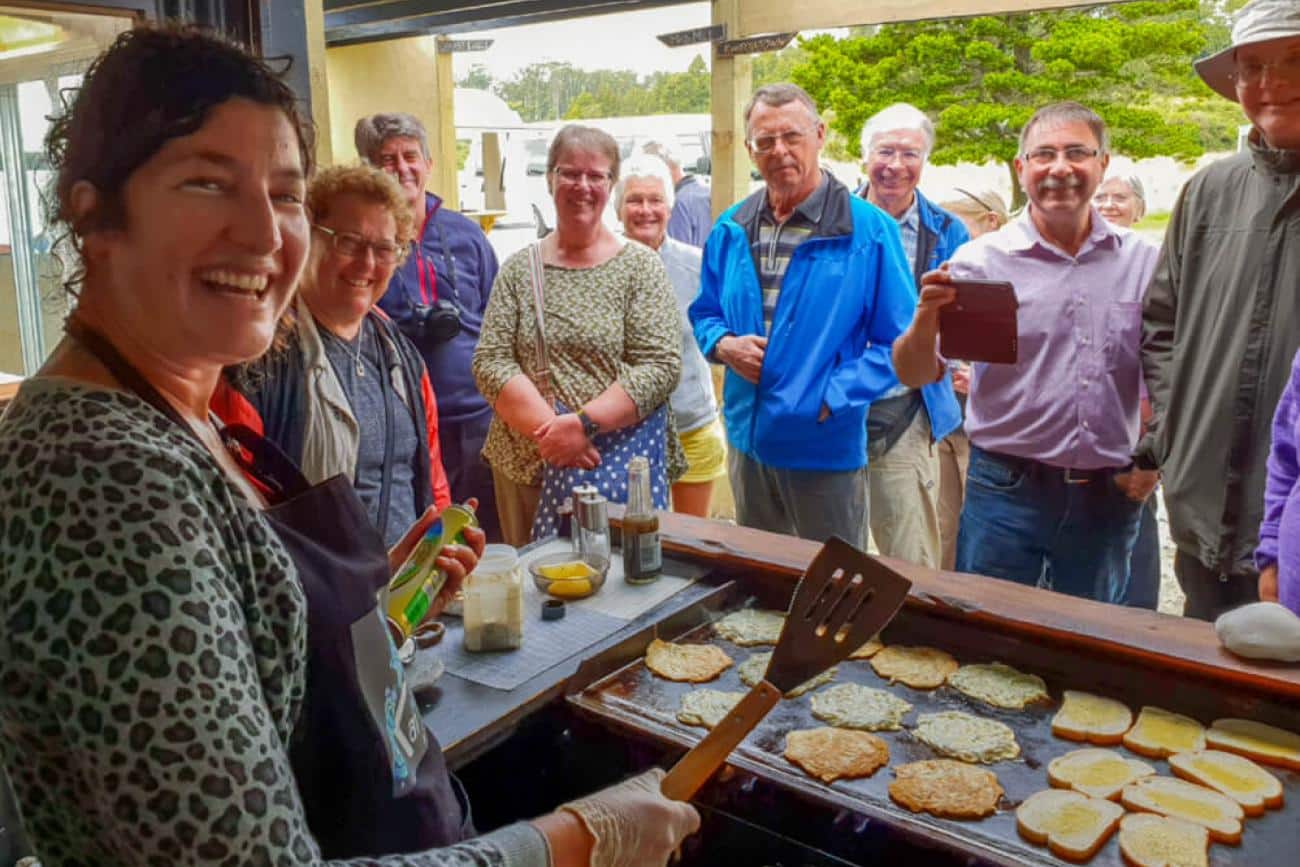
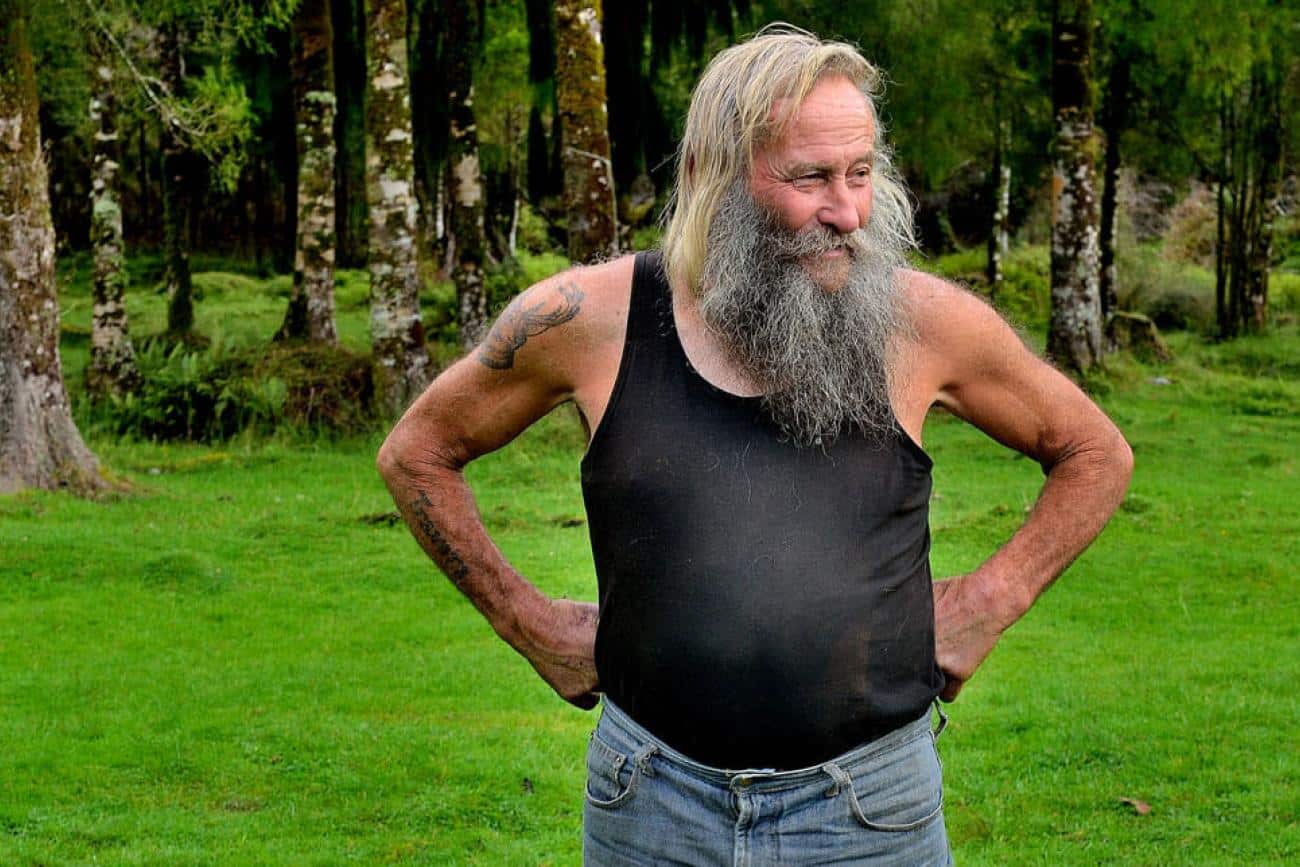
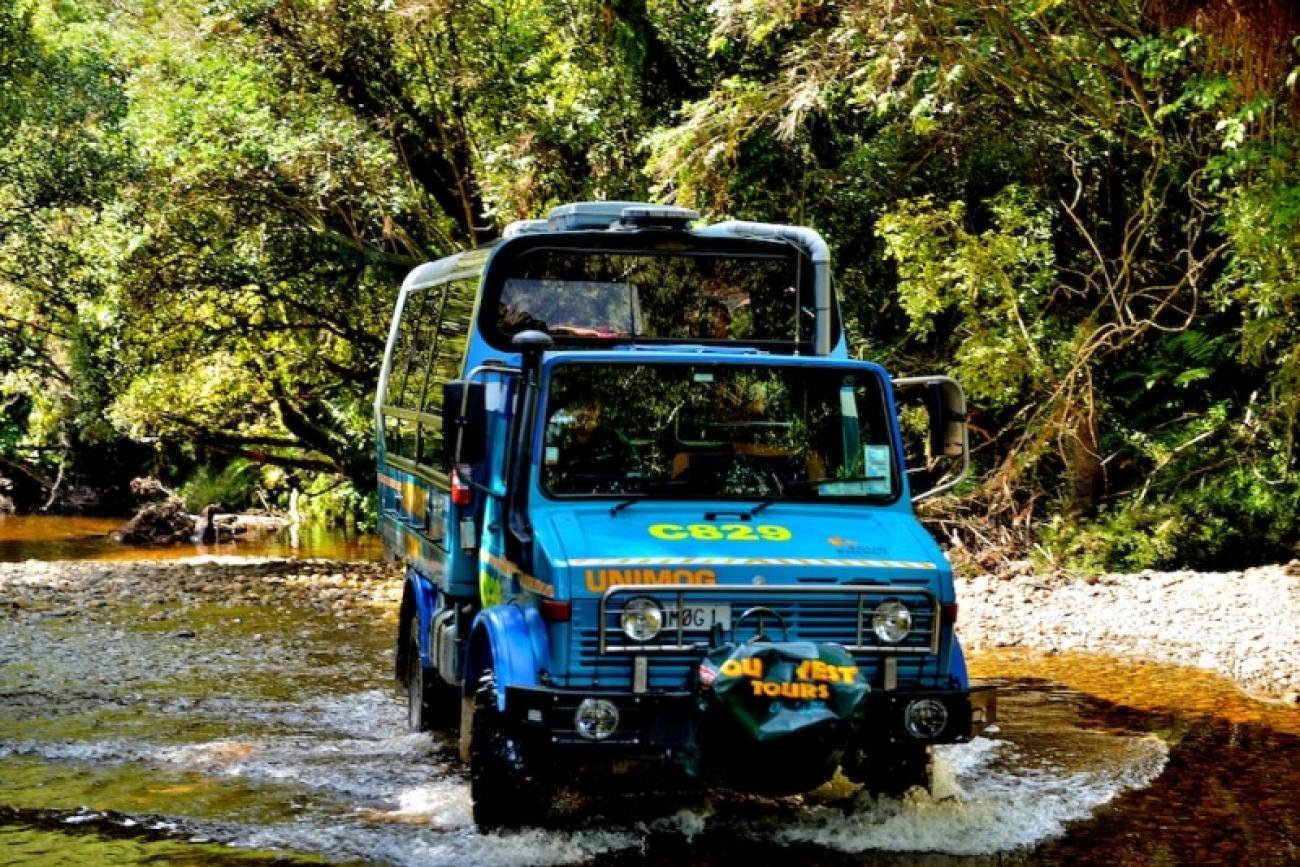
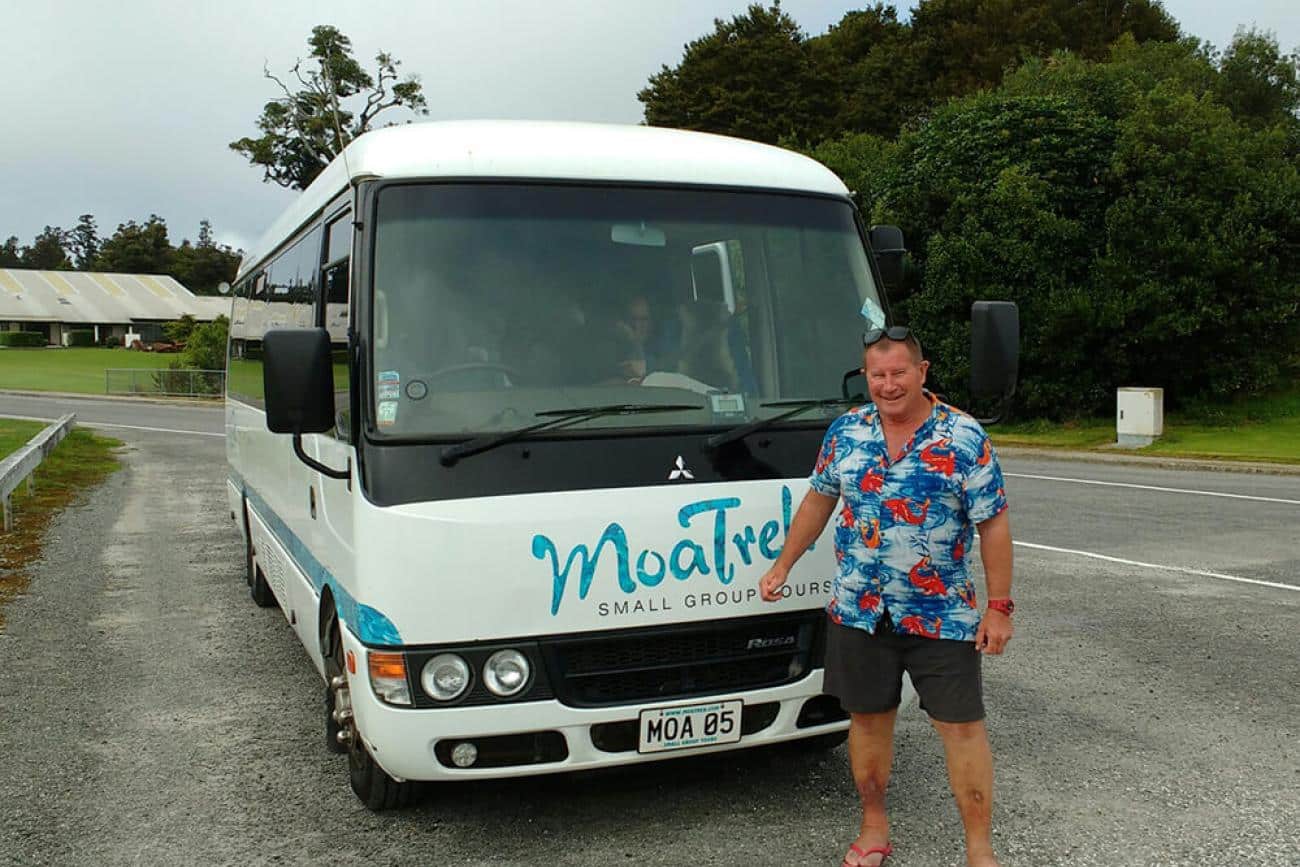
Andrew: Yeah. And it’s fascinating the kind of European history on the coast. People don’t realize that Hokitika was one of the biggest, kind of, settlements in the country. You know, we’re talking back in the 1870s, and there were plans to make it the capital of New Zealand. And there were direct steamship connections from Melbourne, you know, and all because of the gold. And so many Europeans have their family ties down the West Coast, which just makes it for a really interesting kind of…for travel and discovery.
Marilyn: It’s great because those of the guests that travel all the way with us from Auckland down through Central and Queenstown, and back up the coast, in a way travel that gold journey, the line of the early old gold miners of the 1860s. Some of them were…he might not have been quite that early, but certainly around Queenstown, and Cardrona in that area. It’s pretty hard at Charleston to imagine that there was, you know, 50 hotels and so much activity when there’s just one building, and a camp ground, and a whole lot of scrubby trees left now.
Andrew: Yeah. Okarito is another one, isn’t it? There were, I think, 3,000 people living there, and now there are about 30, 29?
Marilyn: Something like that, and wonderful white herons.
Andrew: Yeah. The home of the white heron. Yes.
Andrew: What about…you mentioned before the people on the coast. Are there any people that you love on the coast? Like, if you had to, kind of, choose someone who you’d say, “Well, this person’s a real coaster,” is there any person or people that are like that for you?
Marilyn: well, Johnny would definitely stick out as real coaster. Absolutely. And the other people that our group are going to meet, any other one would be Slade and Paula at Okarito. And Slade…I’m not sure where exactly he worked on the coast, but I first met him down at Lake Mapourika, and he worked for someone and then started his own business at Okarito. He’s just so passionate about what he has there. He’s so inclusive. He takes people out to have a look at the white heron and all the other birds on the lagoon and in the little side streams. And so he’s probably an example of how you can do whatever you like on the coast, and you kind of accept it.
There’s also…you don’t generally see the person, but in Hokitika restaurants, you often see stone mats made from stones off the West Coast beaches. And that man standard off gold mining, and he wasn’t very successful. And he had piles of stones at the end of the day, and he kept looking at them and thinking, “What can I do in?” And now he has this wonderful business making…you know, just using a local resource, of which there’s so many of, making mats for tables and mats for doors. Those are the things that are fascinating on the coast.
And people often traveling really liked to meet the people that are…the small family businesses where they do things…activities like Slade’s, or in Hokitika, the carvers that are actually doing the carving, the pounamu that people buy, that connection with people. And I remember one time having a man onboard, and he really wanted a piece of raw pounamu to make something for himself.
Andrew: So, what’s pounamu, for someone who doesn’t know?
Marilyn: Greenstone. So it’s New Zealand jade, but the local name is pounamu. And the carver was a little reluctant. You know, this stone’s very hard. You’re not going to be able to do anything with it. And the gentleman said, “Oh, don’t worry, I’m a dentist. I’ve got access to all sorts of tools.” So they had a good old laugh, and he did sell him a little piece of pounamu.
Andrew: So it’s the kind of jade, the carving capital of New Zealand. And I love when we pull up, you can actually walk right in and see people, you know, the carvers working on the pounamu right in front of you. And there’s three or four places you can do that right in Hokitika.
Marilyn: It is. It’s wonderful and people often come away with a place where they’ve met the carver, and so the stone is significant for them as they travel.
Andrew: Just going back a little bit, you mentioned Okarito, which is a really cool little place. How would you describe Okarito to someone who’s maybe on the other side of the world and has never been there, and is maybe looking at it online and seeing a photo or two? How would you describe Okarito to someone?
Marilyn: I’m biased when it comes to Okarito. I love it. It’s a little coastal settlement. There’s no shops. There’s about, I think, 13 or 14 families that live there. It’s just huge big lagoon that’s open to the sea, and the lagoon comes in and spreads huge distance up almost parallel…well, parallel to the coast. And it’s tidal so there’s all sorts of wading birds and sea birds there.
And the little settlement itself, on a beautiful day, you can stand by a little old school and look up at Mount Cook. And so it’s a little example of what maybe the area was like before it was very, very popular with tourists. So, yeah, it’s a beautiful place, winter or summer, it got a little beaten up with Cyclone Gita along the coast but I think it’s starting to recover so the little shrubs and things along the coast got windburned and knocked around, but a really tranquil place.
Andrew: Yeah. And, can you tell us a little bit, for someone who has no idea about what Slade and Paula do there?
Marilyn: Okay. Slade’s got a boat that has quite a shallow draft, and they take people up the lagoon in it to look at the white heron, which are really special in New Zealand. There are white heron in another parts of the world and they’re related, but in New Zealand culture, and Māori culture, the white heron is particularly treasured, and you can see them, particularly at breeding time, with their beautiful feathery, lacy plumage in the lagoon, and the and other sea birds.
And he can edge his boat up very narrow waterways with the forest folding over you, and see some of the native birds as well. So he really takes you on a birdwatching trip. And Paula will take you for walks through Okarito itself, and tell you about all the history of the area, and the gold rush, and what happens today. So it’s a really nice little tour that includes something about people’s history and something about the natural history of the place.
Photos from the Okarito Wildlife Cruise with Slade
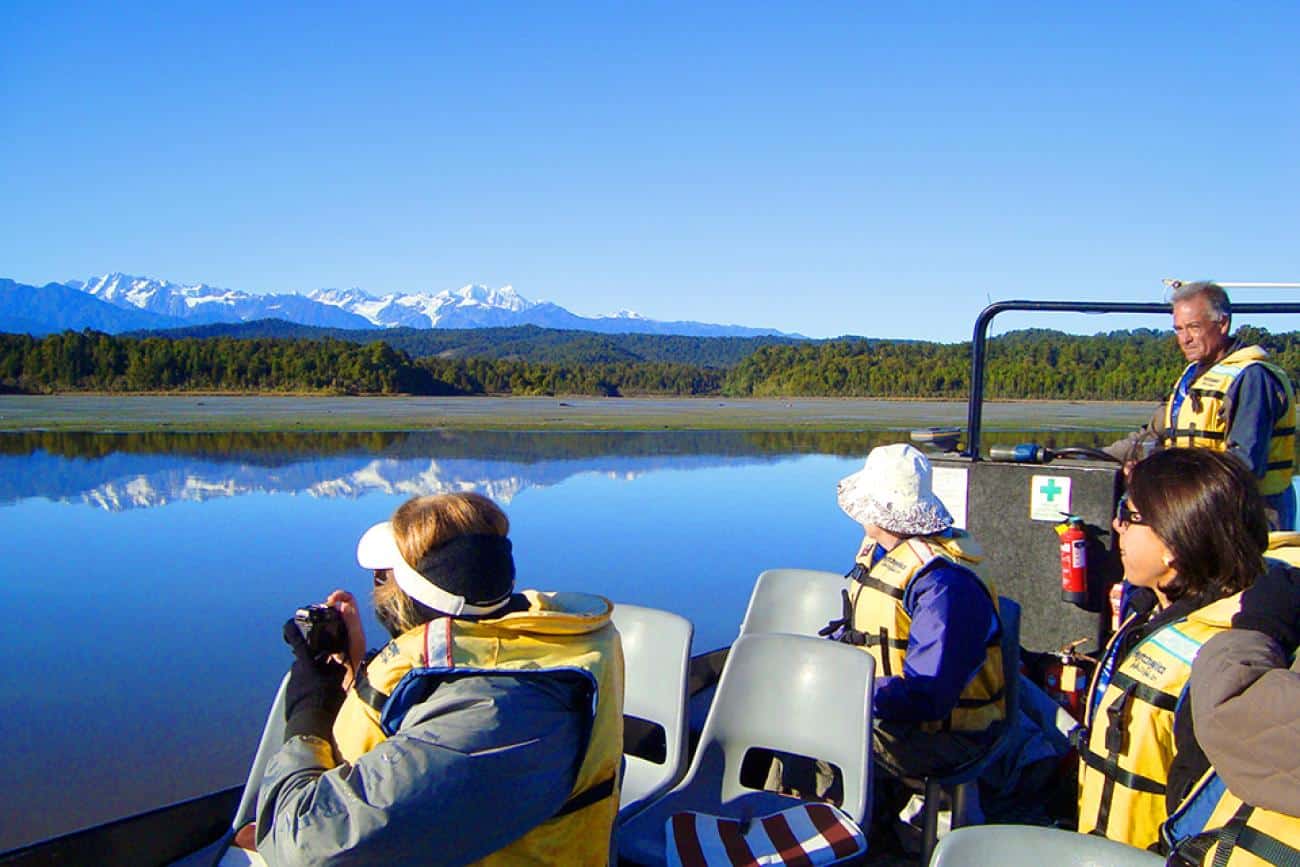
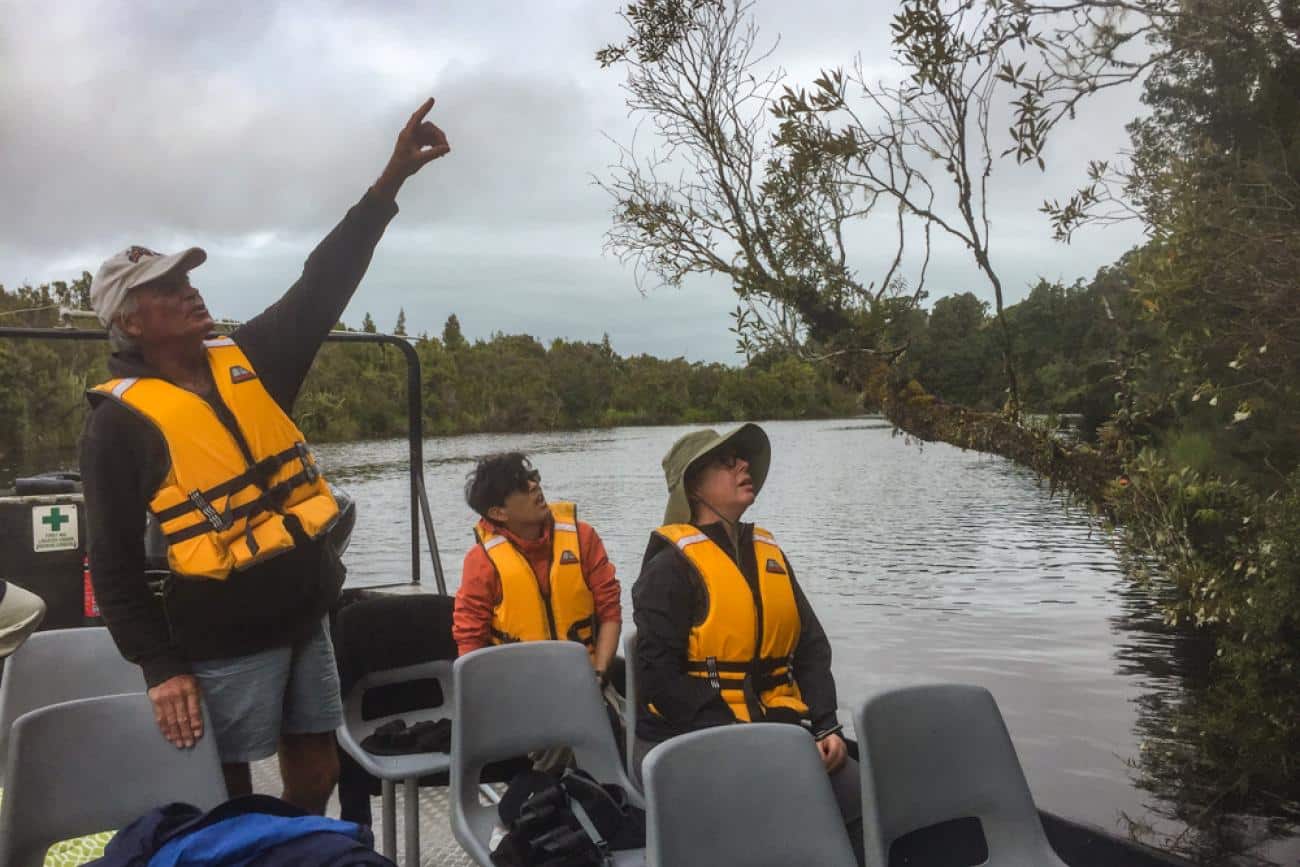
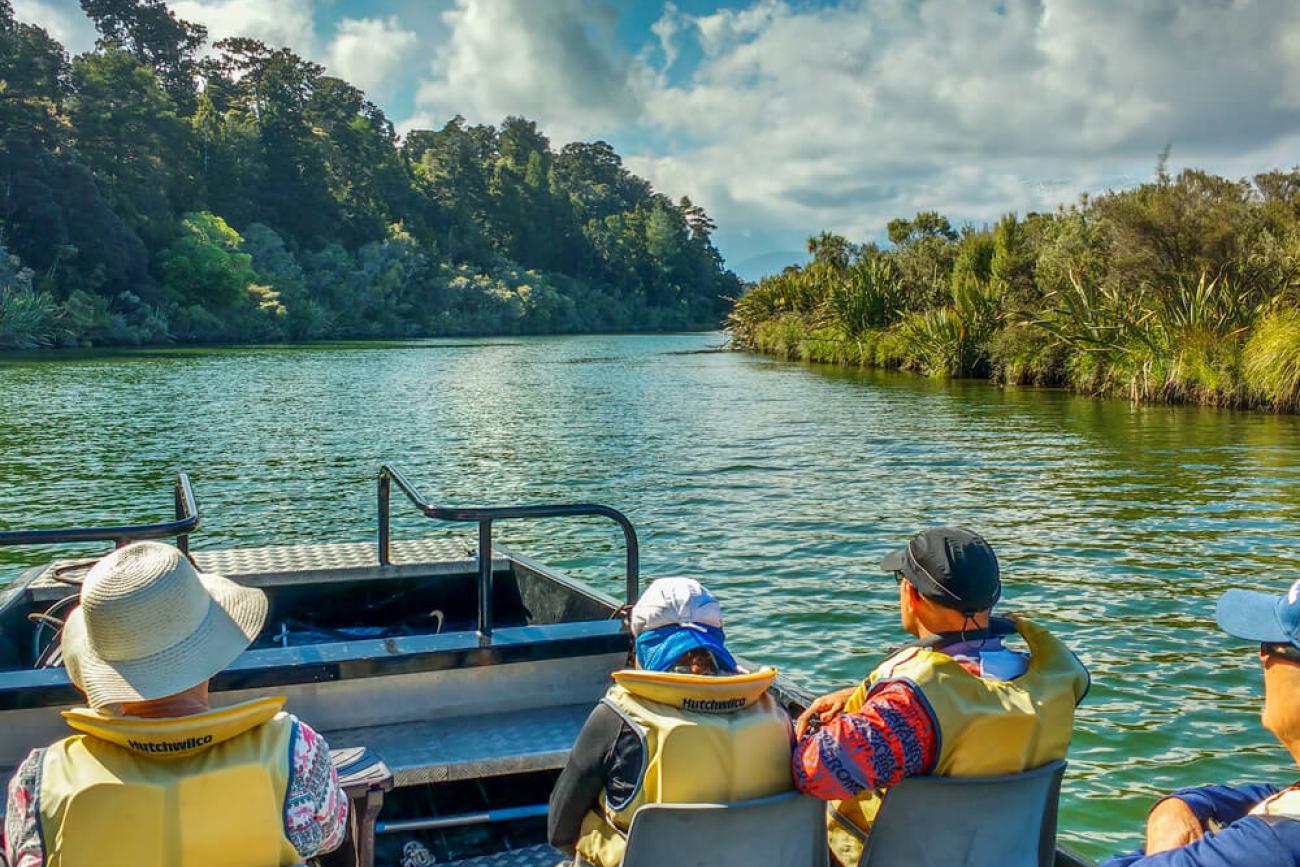
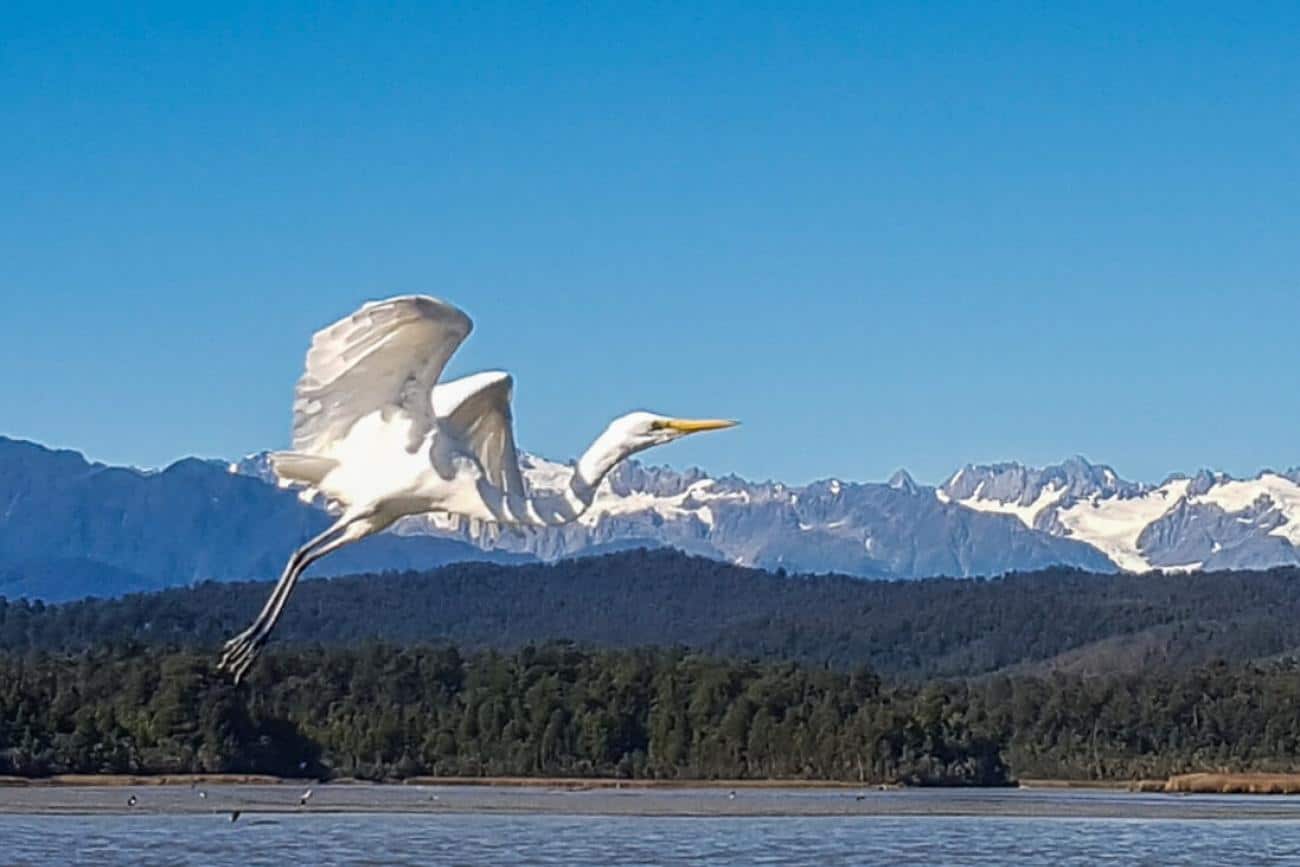
Andrew: And… Go on, yeah.
Marilyn: I didn’t mention those of you that perhaps are people that are birders, there’s also the wonderful walk up to the Okarito Trig. So it’s a viewpoint that looks all the way up the lagoon, and on a perfect day is your wonderful, wonderful view of Mount Cook and Southern Alps.
Andrew: Yes. And it’s off the main road, so what is it, about twelve kilometers off the main road. And it’s a little bit of a windy road, so the big buses can’t go down there. So that’s what’s great about it. Yeah, meet people there, but you’ll never see a big coach down there because, you know, they can’t make it down the windy road.
Marilyn: Yeah. It’s a beautiful drive as well.
Andrew: But not too long, thankfully, for the driver. And whenever I go there, Slade’s my…he’s such a…as soon as I drive and I look at Slade, if he’s wearing…I’ve never ever seen him anything other than wearing shorts. I think if Slade was wearing long trousers, I think we need to prepare for the end of the world. And he just looks like he has been on his little boat walking or, you know, showing people up waterways all his life. And he certainly knows it. And he actually goes up to…because his partner is Canadian, Paula is Canadian, I think, originally…and they go up and do the same kind of thing, is it, somewhere up, Alaska or somewhere, North America, anyway.
So he’s a very seasoned nature guide, and he’s taken, you know, camera crews from the likes of the Discovery Channel, I think and National Geographic around Okarito, you know, so really one of the most experienced, kind of, outdoor nature guides in New Zealand, and just such a down-to-earth guy, and I always enjoy, as I’m sure you do, catching up with those two.
Marilyn: Yes. I hadn’t thought about the shorts, but almost shorts and gumboots, or Redbands, or Wellingtons if you’re from the other side of the world, are pretty much a part of the coast because sometimes the weather is damp, or the ground is damp, and it’s just a very practical way to get around that. Also, it’s not that cold, even in the winter.
Andrew: No.
Marilyn: It never gets particularly cold. So, remember it’s that temperate rainforest, so quite a mild climate really.
Andrew: Yes. So, we talked a bit before about… you mentioned Queenstown, because most people…I mean, people start their journey from Queenstown and come through Wanaka, and then up the coast. Now, everyone loves Queenstown, but how would you describe to someone who’s thinking about coming to New Zealand the difference between a couple of days in Queenstown and a couple of days on the West Coast?
Marilyn: It’s an incredible contrast. So, everybody is aware or has heard of Queenstown, it’s a busy activities center or a tourist…it’s really a little tourist mecca. There’s lots of activities to do there, but the mountains…and beautiful mountains, but they’re all…it’s mountainous, it’s a tussock landscape as we come through to Wanaka and come up. And so you transition from a busy, vibrant place, so Queenstown, through this wonderful, golden, tussock landscape as we come up over Cardrona, or over the Crown Range and down to Cardrona, and follow that through.
And then, from Makarora the vegetation and the pace of everything changes. So it’s only really recently that there has even been cell phone coverage or Wi-Fi coverage on the coast. So what I used to love was we’d leave Wanaka, and no phone coverage until we reach Fox Glacier. And so there’s this real sense of leaving everything behind for awhile. But the contrast is really wonderful experiencing both. They’re quite different experiences. So it gives you a sense of variety, how much change can be packed into a very short distance of traveling with…the tour would be five days, I think, isn’t it?
Andrew: Yeah. I mean, Queenstown and Wanaka are, kind of, massive glacial lakes, and they’re, kind of, big Alpine scenery, and then in just a couple of hours, you’re down in the rainforest, and those deserted beaches you talk about in just a single day, even half a day, really, from Wanaka through to the coast.
Marilyn: It is. It’s a magnificent contrast, and you leave all those huge glacial lakes behind and you end up with the wonderful little deep brown-water lakes of Mahinapua and Ianthe and Mapourika as we come up the coast. So the size of the lakes, the water is still there, but that the lakes have changed in size and the color. And that beautiful color of tea that’s in water on the West Coast, that’s quite contrasting to the glacial waters of Wanaka and Wakatipu, Queenstown.
Andrew: And I guess the lush rainforest is what hits me on the coast, that’s, you’re just surrounded by this…like Franz Josef, for example, the township itself is just surrounded by this lush, kind of, green fern and podcarp forest everywhere.
Marilyn: Yes. And in the evening, for those that are keen, you can just walk out 10 minutes from the little township, or from where you’ve eaten your last steak, and walk up a little track, and see native glowworms in the forest. So instead of having gone to a cave…well, they’re different from when you see them in a cave, because they are twinkling out amongst the mosses and the ferns, and it’s just quite a little magical experience through there, and some times that’s what we do in Franz Josef, for people that are interested.
And, again, it’s okay to walk in the forest in New Zealand at night. There’s no nasties that are going to leap out and grab you. And evenings, too, In Franz Josef, you still also have the kea, our native parrot, and the only alpine parrot in the world. He’s often flying around the trees just above the village, and the birds that you hear at night, you can often hear the morepork there, our native owl, and everything is just walking distance away really.
See the contrasting countryside from the Wakatipu through to the West Coast
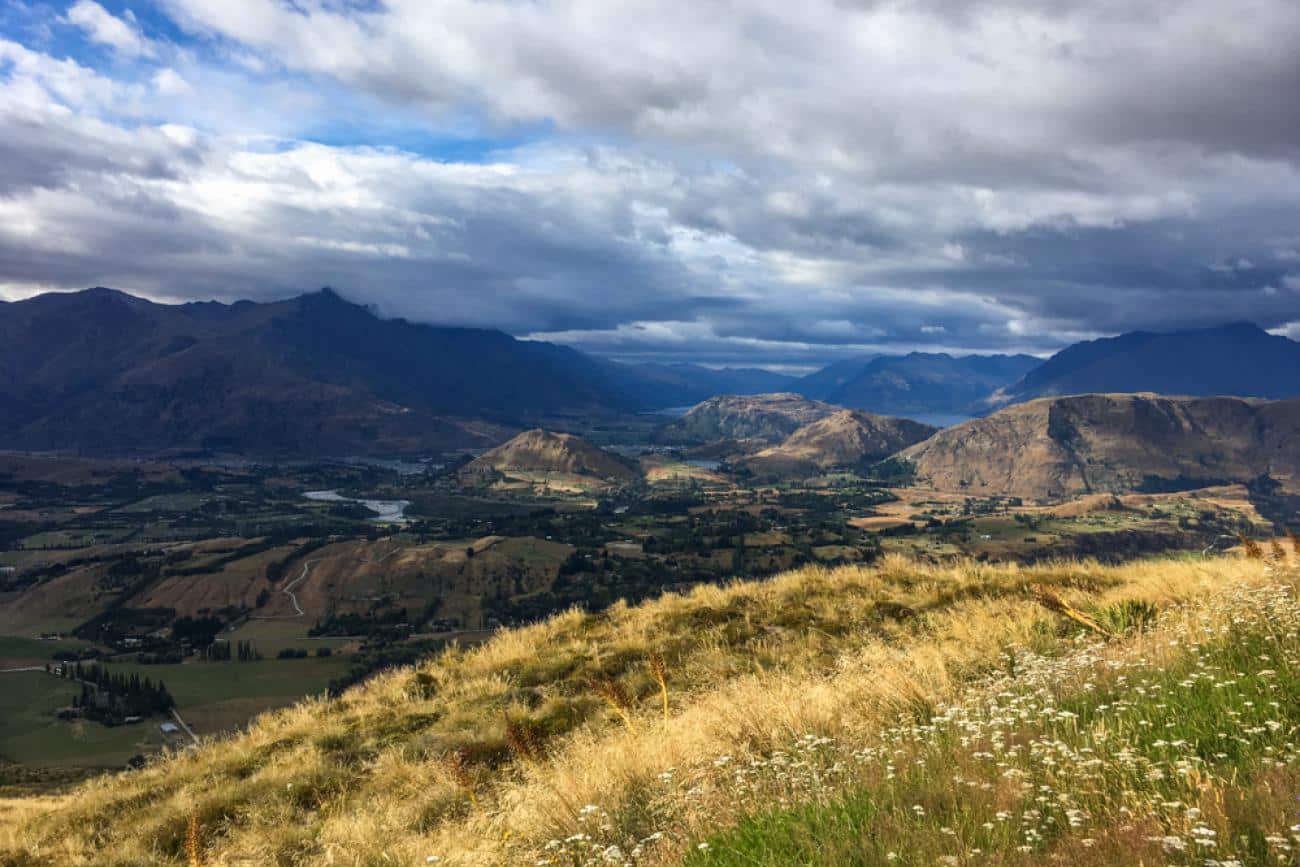
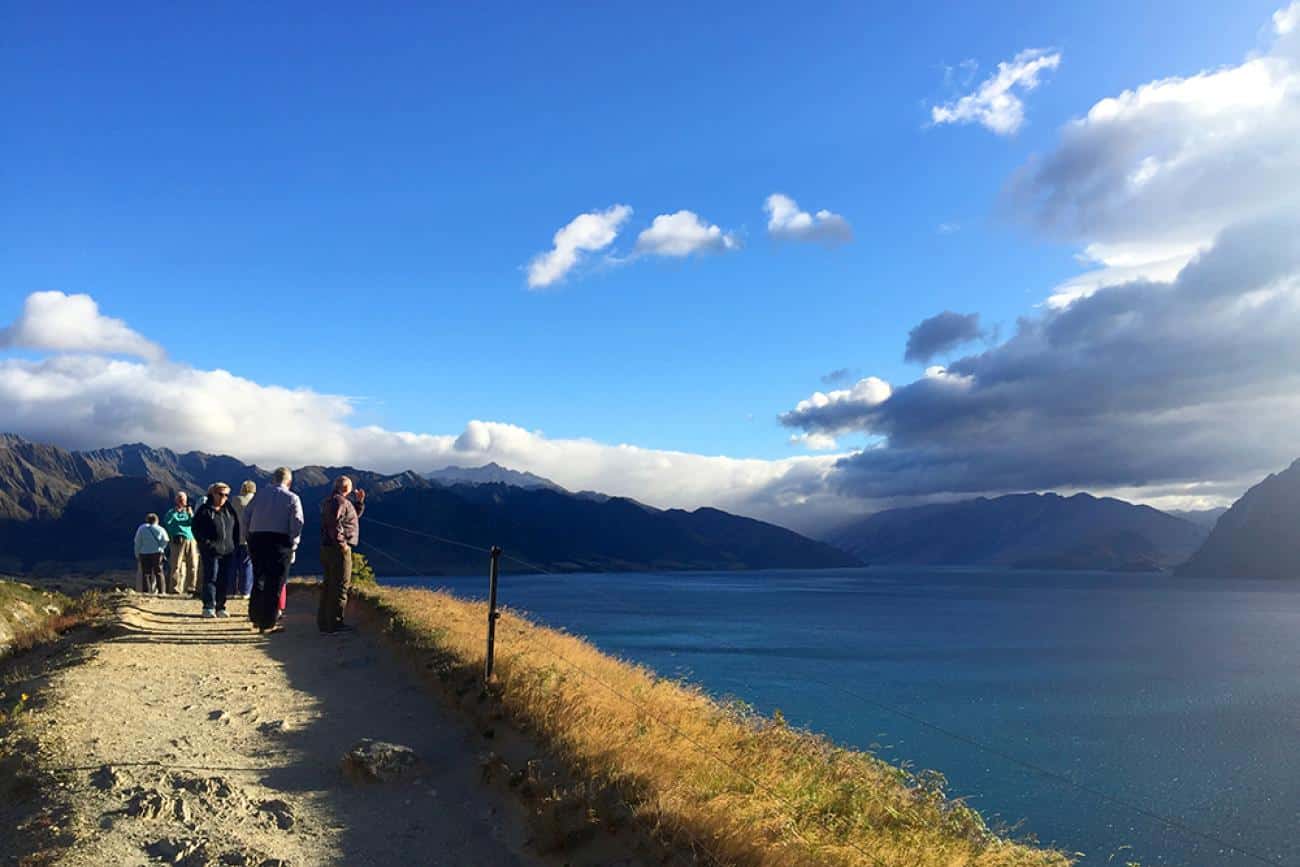
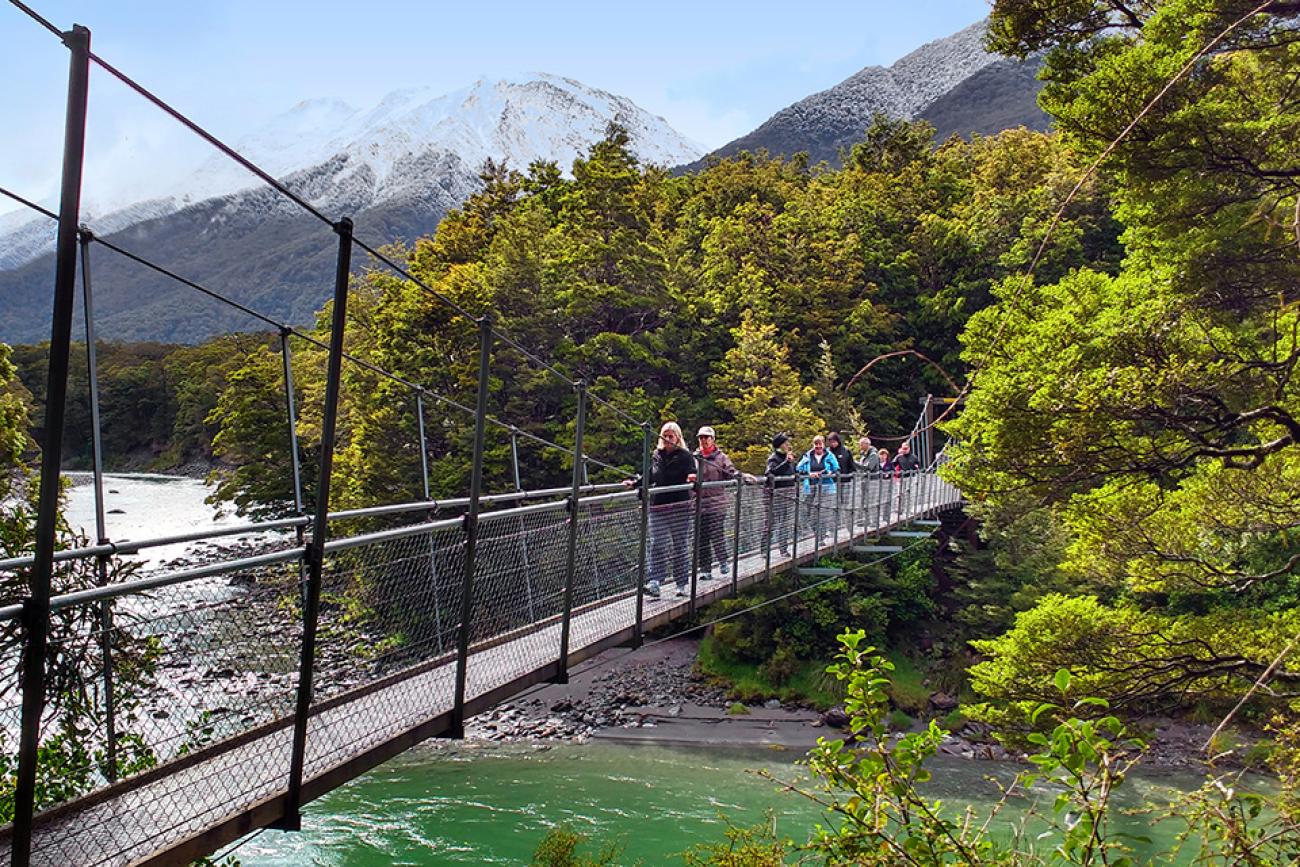
Andrew: And, I mean, talking about contrast, we’ve even got lots of contrast on the coast. So, you know, Franz Josef, the glaciers, the forest, and then after Franz Josef, we go up and stay in Punakaiki, which a lot people don’t make it to because, you know, it’s a little bit past Arthur’s Pass road. So how would you describe the differences in just that short trip from…and, you know, one day you get about a half-day trip from the Glacier Country up to Punakaiki, and that area? And what do you like about Punakaiki and Paparoa National Park?
Marilyn: So, what you leave behind is the glaciers and the beech forest, and you’re in that wonderful coastal forest with our Nikau Palms, our native palms, wonderful limestone formations. So, throughout New Zealand, there’s little pockets of limestone landscapes, and, in a way, is one of those places that has those wonderful, wonderful limestone escarpments, and the Nikau Palms that stand up against the coast there.
That is the contrast, quite a different forest type, after Christmas, you see the Rata, the beautiful red lush of flowers amongst the forest. And you’re right on the coast as well in Punakaiki, so when the weather is calm, you can swim in the river and the Tasman just thunders in on the beach there, and is just quite a spectacular site.
And you’ve got the Pancake Rocks, so you see the stacked limestone and all the wonderful formations there, and just a walk away, so we will go and have a look. But people often go back to look at it again in their own time while you’re in Punakaiki. So it’s the rock formation, so you go from glacial weathered rock to these wonderful limestone formations. And a beach people can wander along and have a fire on. And often you have oystercatchers just outside the hotel, and for two or three years a pair have raised their young just along the beach, and if you wander along the beach quietly, you’ll often see them there with their one or two young chicks at the right time of year.
Andrew: Yes. And I always love finishing the trip in Punakaiki, you know, two nights, it’s such a great last little stint on the trip. And, you know, the sunset on the beach, you know, often people will come out and have a drink on the beach. And so, even like a little poignant moment when the sun’s setting and it’s our, you know, last two nights of a trip, at the last night, everyone will go out on the beach, and it’s a great place, because it’s very secluded that hotel, is nothing around it. It’s almost like your own little private beach. So that’s what I always love about finishing up in Punakaiki. Well, we should mention that it’s not a swimming beach, is it, Marilyn? You wouldn’t jump in for a swim at Punakaiki.
Marilyn: No. In fact, I always say to our people with me that the West Coast is not for swimming in the beaches. The rivers and the lakes are the wonderful swimming holes, for the swimmers that come along. If it’s a dead calm trip up the coast, people often wonder why it’s not for swimming. But once they see that sea pounding and…and at Punakaiki, if someone looks like they’re going to go swimming, usually someone in the hotel, one of the hotel staff rushes out to…
Andrew: And tackles them.
Marilyn: …warn them off.
Andrew: Yeah. You do have a few surfers in there, don’t you?
Marilyn: Pardon?
Andrew: You see a few surfers in there from time to time?
Marilyn: Over with the village is.
Andrew: Over on the other side. Yeah.
Marilyn: So there are surfing beaches, but very strong currents, and river is a much better place to be swimming. And the other thing about Punakaiki is that we often have a meal down at the local hotel, and there’s an eclectic collection of local people and travelers, and that’s really nice, you often see an exchange of people traveling and those that live locally having a chat. And the opportunity to meet locals along the way is something that people always enjoy, so having that interaction, and with a smaller group, and also a little out-of-the way places that we go, there’s a greater opportunity for that.
And last season, actually it was down at Haast, but one of the passengers wanted a possum skin, so brushtail possum from Australia, which of course is a pest to us in New Zealand, so it’s an OK skin to have. And he really wanted a skin, and we stopped in Haast, and he shot across, there’s a wee gift shop, and a local fellow tans the skins and sells the meat. So he ended up with his possum skin at a much, much cheaper price than you see them in Queenstown.
Andrew: Yes. The possum, it’s a beautiful fur, isn’t it?
Marilyn: It is. And they are a beautiful animal, but not in New Zealand.
Andrew: Yeah. Unfortunately. An introduced pest here, which is very destructive to our native forest, so we try to get rid of them. But what are we up to? About 40 million or something? So we’ve got a way to go. Now, well, just to finish off, Marilyn, I just wanted to ask you a couple of little tips about travel to the coast. So, do you have a culinary tip, a food and…I won’t say wine, I know there’s no wineries on the coast, but a culinary tip for anyone that’s planning a trip down the coast?
Marilyn: I think that it is well worth trying the whitebait, because that’s where they come…well, where the bulk of them come from, and tasting. The coast is…yeah, that’s a tricky one, really, but there’s always good food. But it is a great opportunity to try the whitebait and I always enjoy a really good steak on the Coast.
Andrew: Yeah. Okay. We’ll put that on the culinary tip then for the coast. I think most Kiwis would agree with that one, the whitebait. And what about a shopping tip? Any goods that you think are, kind of, a have-to-have souvenir from the coast?
Marilyn: For me, it’s a piece of Pounamu because it comes from the rivers of the coast, so you’re taking something special home from the area, so the rivers around Hokitika, are where that greenstone or the pounamu comes from. And I think it’s a great…it’s small, it’s easy to carry, and you’ll have it for a long, long time. It’s a wonderful piece to take home. And the other thing is beautiful pieces of driftwood off the beach, as we walk and take them home and polish them. So, shopping on the beach. And even some of just the polished gemstones, or one person last year took some home to polish himself that he picked up. So, yes, some really lovely pieces to be seen.
Andrew: Yes.
Marilyn: That would be my shopping tip, or the socks lady, you know. I’ve got a pair of her socks that…
Andrew: Are they possum socks or normal wool?
Marilyn: They’re wool socks, and so you do need to look after them a little more than just throwing them in the washing machine. They’re really nice evening socks on a winter’s evening, they’re soft on your feet.
Andrew: Yeah. That greenstone, the pounamu, that was, people may not realize, is a precious stone to the Māori people, and they made weapons and pennants, and tools out of it, but it only comes from the West Coast of the South Island. So all of the greenstone in New Zealand originates from down there. So that’s what special about that.
Marilyn: Yes. And it ties into the things we talk about as we travel and we see the old greenstone trading routes or areas that the Māori came to the coast to collect and so they took the greenstone and traded, or they traded greenstone for other things that they needed further up the country. And so…well, the greenstone is broken down into a number of different types…the Māori see it as different depending on its coloration and where it’s come from. They also get, further down towards Haast and south, there is the Tangiwai which is not strictly a nephrite jade, but it’s still very much valued, it’s softer than nephrite jade, but, again, a beautiful stone inside. Yeah. That would be my pick.
Photos from Punakaiki and the Pancake Rocks
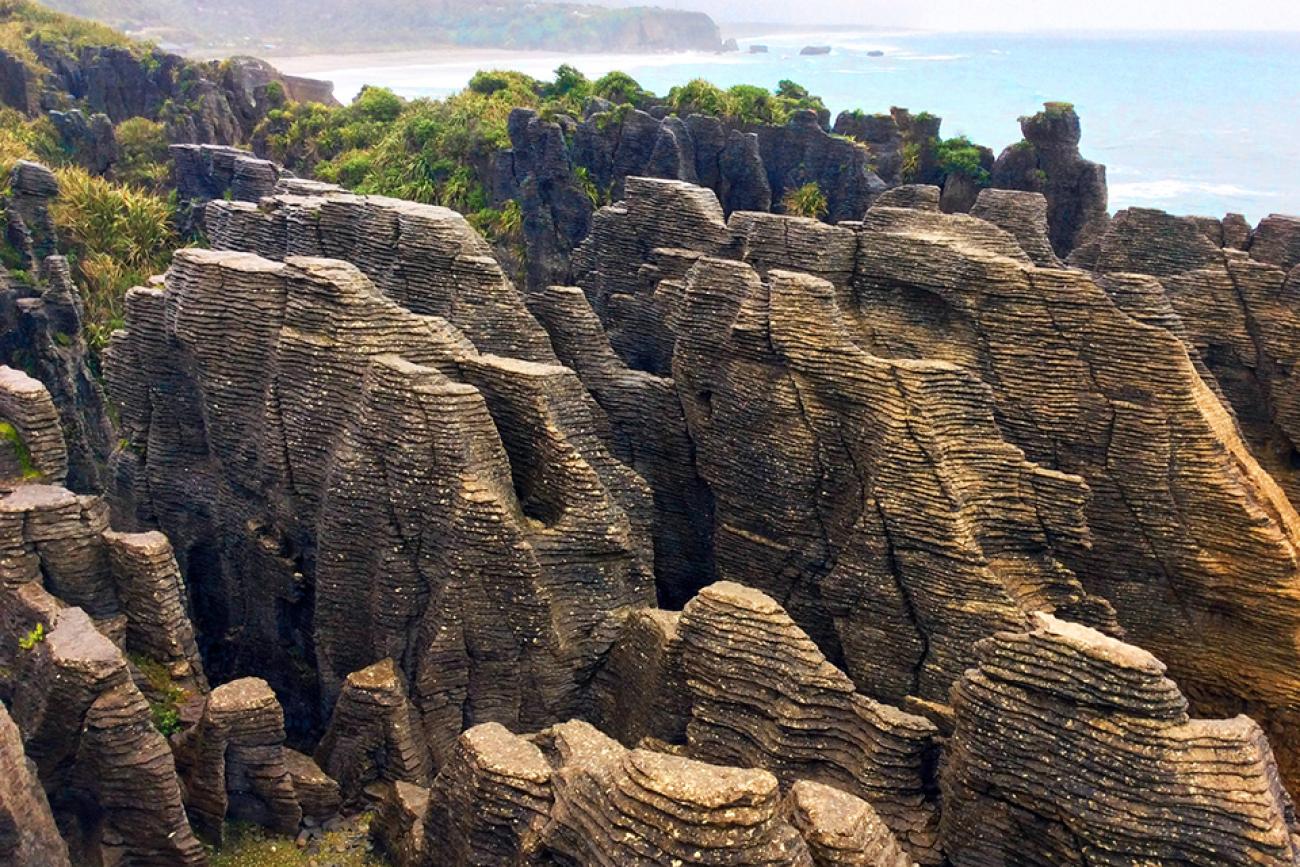
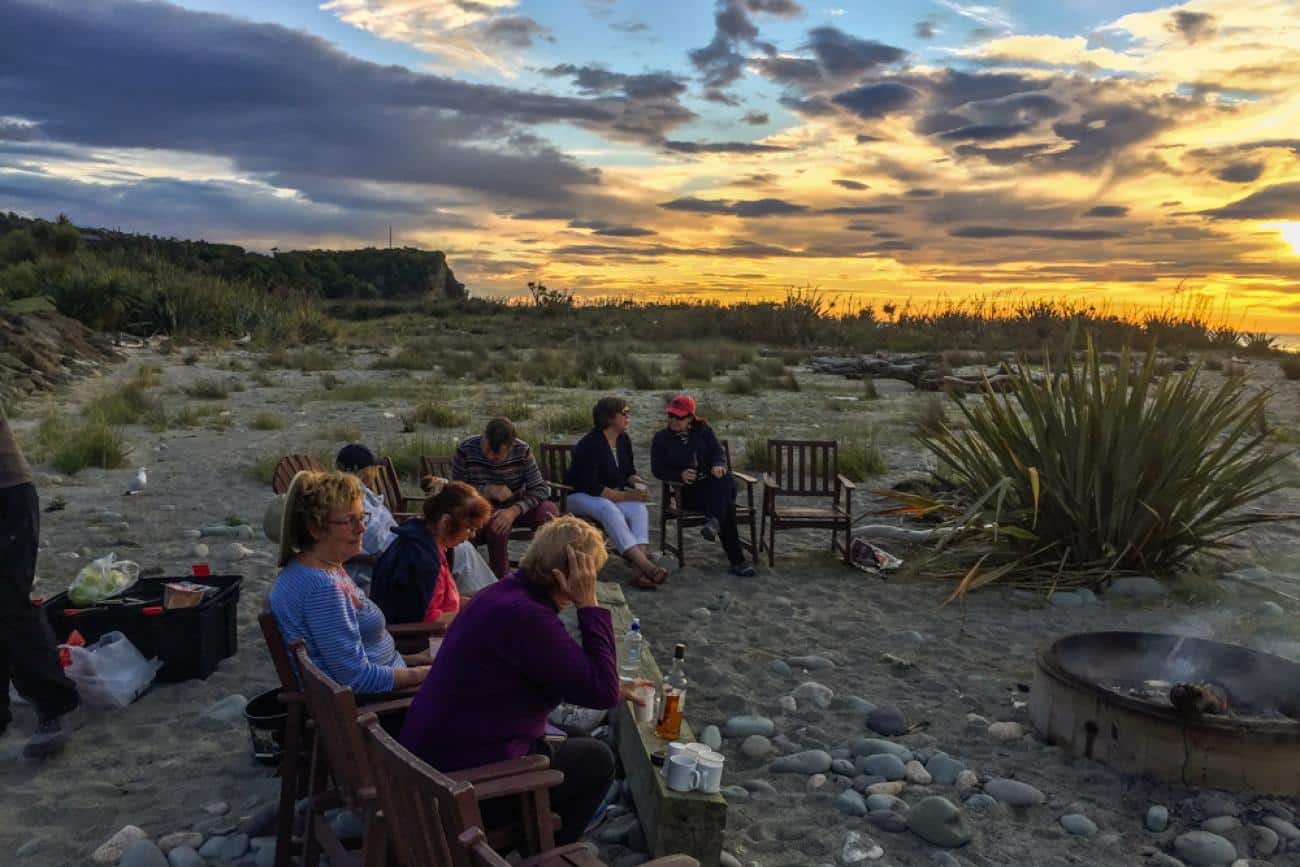
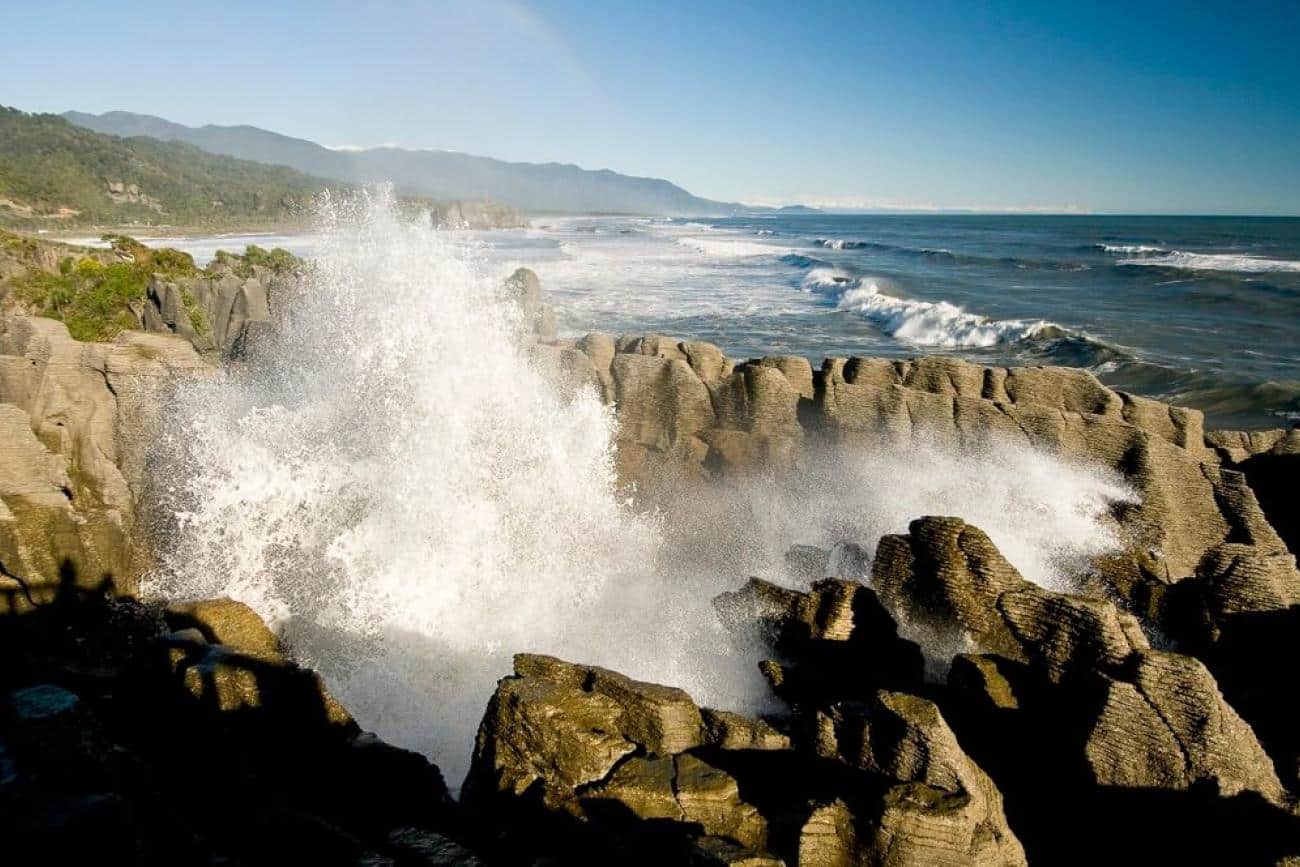
Andrew: Yeah. Pounamu, so, yes, good one. Any general travel tips for people visiting the coast? Just, you know, little short things that you think might help anybody before they left home, something to bring or something like that? Just some general travel tips that you’ve seen from your experience may help people preparing for a trip when they visit the coast, for when they come to visit the coast in New Zealand?
Marilyn: A raincoat and an umbrella, I think. Although I did have an Englishman travel, who wore shorts like everybody else on the coast, the whole way, but we do have a lot of sandflies on coast, so people that don’t like being bitten, it is a little biting fly. And it goes to sleep at night, so you don’t have to worry about it in the evening. But a pair of light trousers if you don’t want to be bitten. And the coast is, there’s a man who makes very good insect repellants.
Andrew: Oh, yeah.
Marilyn: It’s better off to use the local one, I think. Yeah. I would think…
Andrew: It’s a natural product, isn’t it? There’s no DEET in that one, is there?
Marilyn: There’s no DEET. And depending what you’re doing with some of the activities in different prices, people don’t want to be using the DEET-based ones because if you’re caving or doing the cave rafting, things like that, it’s really hard on life jackets and neoprene. So people ask for you to use the local one. The coast is casual, so comfortable clothes…
Andrew: It’s pretty casual.
Marilyn: …good sneakers that…and actually, to some extent, be prepared to get your feet wet if you’re out walking, so sandals or light shoes that dry out quickly are always good.
Andrew: Yeah. I always find that just a good jacket, something you can take off and on quick, and, you know, light clothing with layers. If you’re on a MoaTrek trip, we have our own umbrellas, so you don’t need to worry about bringing that. But, yeah, it’s part of the, kind of, charm of the coast, isn’t it, whether their, you know, four seasons in one day and, you know, sunshine to spring, to autumn all in one day is pretty standard for the West Coast. That’s all part of the charm, and that’s what keeps that beautiful rainforest green.
Marilyn: Yeah. And there’s some wonderful books in Hokitika that have a history of the coast. It’s always good to, once you’ve visited somewhere, to take away a book, maybe “The Luminaries” or one of the others. If you’re going up to the Denniston Plateau, by Westport. And it gives you a real sense of the place as well.
Andrew: Yeah
Marilyn: So, reading it.
Andrew: Yeah. People often say that they like to read books before or after their trip. The other one, of course, is “The Bone People” by Keri Hulme, who lived in Okarito for many, many, many years.
Marilyn: I had several goes at that one but I couldn’t finish it on it, I’ve had several goes reading it, but I’ve never finished it.
Andrew: Oh, I did. It’s a powerful book, you know, definitely takes you into the into…the spirit of the coast is strong in that book, isn’t it?
Marilyn: Yes. And every trip there’s something different, when I was cycle touring. For a number of years, we had an Englishman who traveled with us every year and did the same trip, and others on the trip would say why? Well every trip was different. The people was different, the weather was different. Yes, the landscape was there but it was changing. So there was always something happening.
Andrew: That’s pretty cool to hear, he was coming back to the same place year after year.
Marilyn: I know. It was wonderful actually. And he just loved the West Coast as well, and he did it on a bicycle, sort of, whatever the weather was. So he had wet trips and dry trips. He didn’t have the luxury of hopping in the bus and staying dry.
Andrew: Wow. Marilyn, thank you so much for your time today, this morning. It’s a Sunday morning here in New Zealand. Thank you so much for sharing all your tips and experiences from the coast. Is there any one final word you’d say to someone, imagine someone sitting off overseas in the UK or the U.S.A, thinking about a trip, and is there any one little final thing you’d say to them about visiting the coast?
Marilyn: Come and do it. It’s a wonderful, wonderful place, and not something you’re going to see anywhere else in the world. That’s one of the thing…vegetation that you won’t see anywhere else, coast you won’t see anywhere else. And MoaTrek is a great company to come and do it with because we try and fit everybody’s needs in.
Andrew: Yes. And, of course, for anyone coming from Australia, the coast is country that you are never ever going to see in Australia. Glaciers, rainforest, and beach all in one day is how I sum up the coast. And, you know, it’s a bit shorter the journey on the coast. You can go up and down the coast just in, you know, seven odd days. So a lot of Australians have been over, to the likes of Queenstown, but a journey through the coast is something that would be…I’ve taken quite a few Australians through the coast and they always love it. It’s very different for them, and obviously much closer, too, just a, you know, three-hour flight or so from the East Coast of Australia.
Marilyn: Yes, yes. And no snakes.
Andrew: No snakes, no crocs.
Marilyn: And good beer.
Andrew: Yeah. And good beer. All right. Well, we’ll leave it at that. Marilyn, thank you, again, and we will put this up on the MoaTrek website, and we’re going to publish it with a full transcript of our chat this morning. And I’ll put lots of photos in as well, so anyone who listens to this can see either, you know, the pictures of the places we’re talking about, we’ll have that up on the MoaTrek website. So, thank you, again, and please enjoy your Sunday.
Marilyn: Okay. And, hopefully we’ll see some of the people looking at this traveling with us in New Zealand.
Andrew: Down on the coast.
Marilyn: On the coast. Yes.
Andrew: Thank you Marilyn
Andrew: So, we hope you enjoyed that chat with Marilyn, sharing her favorites from the West Coast of the South Island. Now, when we travel the West Coast on our Kea 7 Day Tour. We start in Queenstown. You have a couple of nights in Queenstown to explore Milford Sound and all the best activities and attractions, etc, in Queenstown. And we head over to Wanaka for a night, and then over the Haast Pass through Mount Aspiring National Park out to the coast, up to Glacier Country, Lake Matheson, Franz Josef Glacier. You have the opportunity to visit Okarito as well.
And then we continue on up through Hokitika, and we stay the last two nights of the tour in Punakaiki, which is where the Pancake Rocks are, it’s a beautiful spot there right on the beach front. Plenty to do around there, walks in the rainforest, Glowworm Caves, guided tours that Marilyn mentioned, with our friend Johnny. And then, to finish, we head over the Southern Alps at Arthur’s Pass, and back up to Christchurch.
So, seven days, small group guided trip, maximum 18 people, comfortable, four-star accommodation, and every step of the way, you’re in the care of your a MoaTrek Kiwi guide who’s a Kiwi, who’s grown up here in New Zealand, and many of us had lots of fun on holidays as kids in the West Coast area. We’ll publish this and lots more information about the West Coast, pictures, travel information, just everything you need to know on the MoaTrek website. So it’s moatrek.com, MoaTrek New Zealand Small Group Tours. Thanks for listening, and we hope to hear from you soon. Kia Ora.
Find out more about visiting the West Coast
West Coast Travel Guide – Common Questions & Answers
West Coast Travel Gallery – Our favourite pictures from recent trips


